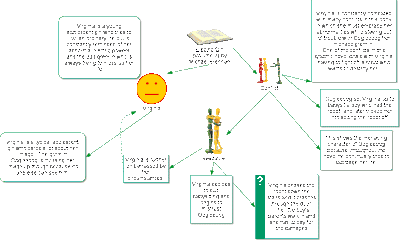
The Magician's Nephew
by C.S. Lewis
Modern Fantasy
Novel
C.S. Lewis's modern fantasy,
The Magician's Nephew, is the first book in the series,
The Chronicles of Narnia. Being that this book is the predecessor to the following books found in the series, Lewis uses this book to explain how the magical land of Narnia was created simply by the presence of Aslan, the magnificent lion who Lewis uses to portray a Christ-like figure in his series. The beginning of the story begins with the tale of two young children, Diggory and Polly who find themselves in an exciting adventure that will change their lives. Due to his mother's illness, Diggory has recently moved in with his uncle and magician, Andrew Ketterly. It is at his uncle's house where he meets Polly, the girl next door. Diggory and Polly decide to have an adventure one afternoon by exploring the attic of her house to see if they find a way into the mysterious empty house found between their houses. Instead, they stumble upon Diggory's uncle in a secret room. His uncle coaxes Polly to try on a new shiny ring he has created which ends up sending her into another world. Diggory follows and by using a combination of two rings, they are taken in and out of different worlds. It is in one of the worlds they visit, where an evil Queen is awakened and many of the children's troubles here begin. After many struggles, the Queen, the magician, and the children, a cabby and his horse Strawberry, find themselves in a dark and lifeless world. Suddenly a beautiful voice begins to sing through the darkness and the world of Narnia is then created. As the world is created by the singing of Aslan, he appoints certain animals as leaders and instructs them that though the world is young, evil has already entered in the form of the Queen. Diggory and Polly are given a task to ensure that evil does not overtake the world by taking a silver apple from a magical tree to plant in Narnia to keep the evil Queen from coming to the land. The silver apple is one that will give unending life, however, if taken and eaten for oneself, the apple will give an unending life of evil. The Queen has already eaten this apple. However, Diggory and Polly take the apple back to Aslan to plant in the land of Narnia. Aslan gives Diggory an apple to cure his mother from her illness. After Diggory and Polly return to their world, Diggory feeds the apple to his mother and then throws the core in the ground. A tree grows and eventually Diggory cuts the tree down to be made into a wardrobe. Thus, there is another tale involving that same wardrobe. This story is quite captivating, I would certainly have this book in my classroom library. I would like to have this piece maintained as a pleasure read, however, this book would be great to read in older grades (4-5) as a literary piece that involves a myriad of imagery and symbolism.



















